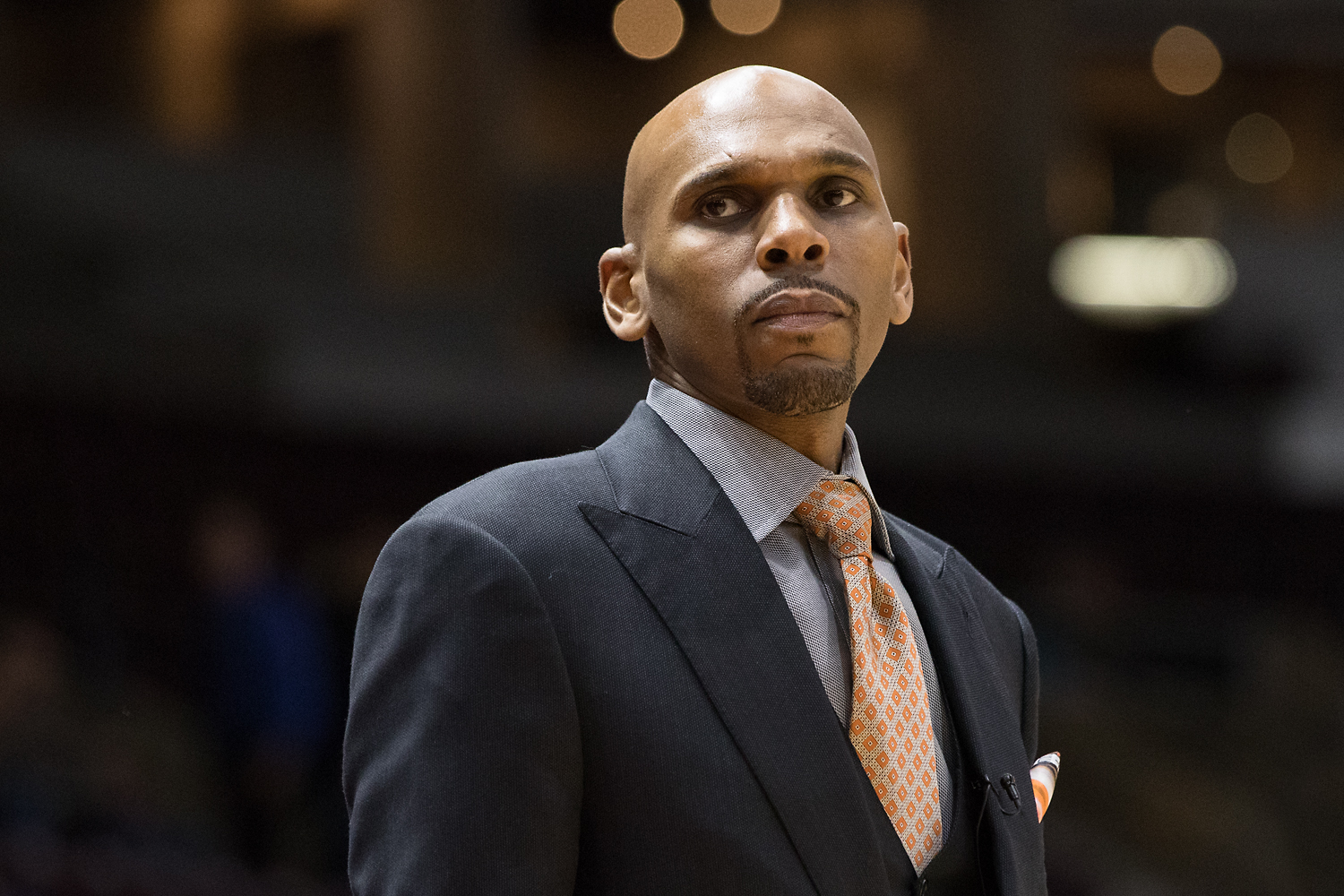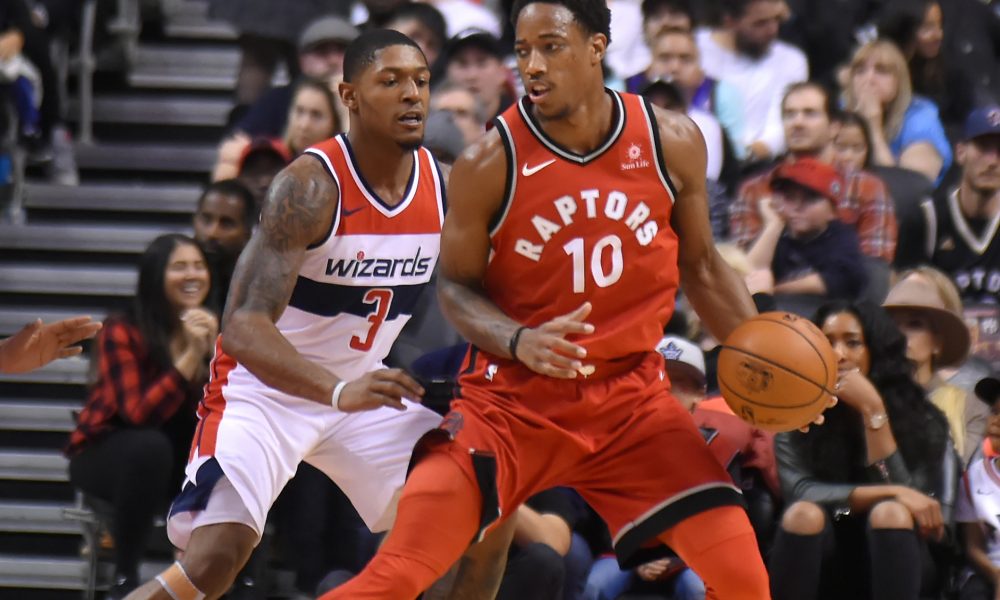The 905 lost the recent contest against the Westchester Knicks on an outrageous moon scratcher (is that a thing? I think it should be) from Nigel Hayes. Hayes is very much a good player, but this shot was very much some bullshit (or just a nice shot, whatever). However, on the play previous, Stackhouse drew up an amazing play. Down 2, Stackhouse got Lorenzo Brown – potentially the best offensive player in the G League, and who had 28 points at the time in the game – isolated and driving downhill against the relatively immobile Luke Kornet. The result was a tie game:
The 905 started the play with Lorenzo running around a pindown screen from Bruno Caboclo. Brown received the ball from Davion Berry on a handoff as Kennedy Meeks stepped up to pick off Lorenzo’s man. Malcolm Miller waited in the strong corner – his shooting acumen forcing his defender to stay attached and unavailable to help. As a result, Kornet was left on an island and predictably gave up an open midrange jumper. Strong screen-setting, multiple talented shooters, and terrific execution combined to tie the score.
But what have Stackhouse’s late-game play calls looked like in general? When the 905 have been down one possession with only one play remaining to make it up, they’ve run a variety of plays. While the above was successful, they haven’t all resulted in baskets. Regardless, Lorenzo Brown is impressed with Stackhouse’s playbook: “It’s pretty deep. That play was designed for me to get either a 3 or a 2… [The playbook] is mostly Stack’s, but I mean there’s some things we do up [for the Raptors] that’s the same thing, but mostly [here] it’s Stack’s ideas. That’s my perception, at least.”
So let’s look at some of his other late-game playcalls.
Against the Swarm, the 905 were down 1 with 7 seconds remaining and Brown not with the team. Kaza Keane threw a quick inbounds to Caboclo, who handed off to Keane. Keane drove as another screen in the lane was supposed to free him further, but didn’t make contact. Keane was able to get an alright look at the rim, but Keane missed the layup over multiple defenders, and Kennedy Meeks missed the tip-in. This was a simpler play than the above Brown shot, but it resulted in a high-percentage look:
Stackhouse also had a chance to show off his end-of-game playbook during the Showcase. In the 905 game against the Sioux Falls Skyforce, the team’s winning streak came to an end. With the team down 3 late, Stackhouse had two chances to get a shooter a look to tie the game.
The first chance came with 15 seconds left. Bruno Caboclo set the higher screen of a double-drag, and then he rolled to set a flare screen for Aaron Best. But, tricky tricky, Caboclo twirled around Best’s man as Kennedy Meeks (the lower of the double-drag screen setters) turned to set a pindown for Caboclo. Caboclo caught the ball with space to launch over shorter defenders who couldn’t bother his shot, but he turned down the look. (This should look familiar.)
Caboclo knew his mistake in refusing to take the shot: “I thought I was guarded, but I just took a bad decision. But we learn from that and take from it, and try not to make the same mistake next time.” After Caboclo drove and had the ball tipped out of bounds, the 905 had to run a baseline-out-of-bounds (BLOB) play to trigger a 3 with only 1.4 seconds remaining.
With Kaza Keane inbounding, the 905 ran symmetrical actions on both sides of the floor. The bigs cross-screened for each other along the baseline to get their defenders moving, and then they turned upwards to back-screen Malcolm Miller and Bruno Caboclo’s defenders. The goal was to free either Miller and Caboclo in opposing corners. Neither player was open, as few of the designed screens actually made contact. Keane never even actually inbounded the ball to a shooter, which led Stackhouse to question his choice of personnel late in the game: “It’s just a matter of [Keane] continuing to grow, late game situations right there. You don’t have time to get the ball in, you gotta try to get it in for 3. Maybe I shoulda asked someone else to have taken it in.” Regardless, Keane had played a solid game up to that point, and Lorenzo was unavailable due to a minutes-restriction.
Earlier in the season, the 905 fought another close game against the Westchester Knicks. Down 1 with 16 seconds remaining, Stackhouse ran a sidelines-out-of-bounds (SLOB) set. The play involved Lorenzo Brown back-screening for Davion Berry, who inbounded the ball to Bruno Caboclo. Caboclo handed the ball to Lorenzo, who pulled back and waited for a ball-screen from Kennedy Meeks. Lorenzo drove, pulling in defenders, and Caboclo walked into a relatively basic screen on Berry’s man. This is the simplest end-of-game play of all; it ended up working as a slow-motion hammer play, resulting in a Berry 3 in the corner. Sometimes the simplest plays work best, and the 905 won the game:
Clearly Stackhouse has some play-calling chops. In the 5 possessions, the 905 scored only 5 points, but 4 plays resulted in makeable looks. Interestingly (small sample size alert!), the 2 plays that involved Lorenzo Brown both succeeded, while the 3 without Brown failed to produce points. Coaches often say that talent makes coaching looks good (or something), and these 5 plays prove that saying to be true beyond any reasonable doubt (or something).
Of the few 905 games that came down to the final shot, two were against the Westchester Knicks. A third game between the two teams was decided by only 3 points. It just so happens that the 905 and Knicks are the two leading teams in the Eastern Conference. Both are led by speedy, talented guards (Lorenzo Brown and Xavier Rathan-Mayes for the Knicks), and the 905 lead the season series 2-1, with each game decided by 3 points or fewer. It would be a dream for the teams to play a series in the playoffs, and in such a scenario, Stackhouse’s end-of-game playbook will surely be put to the test.



